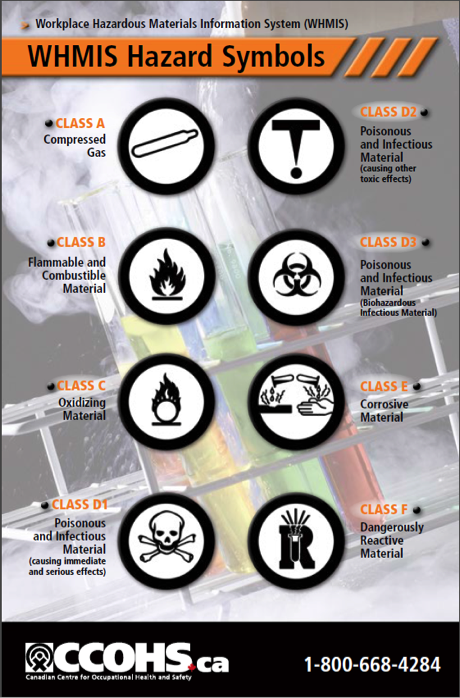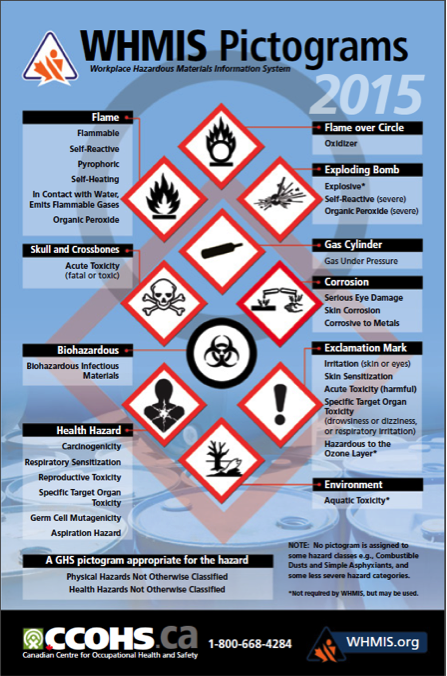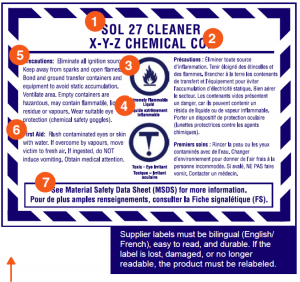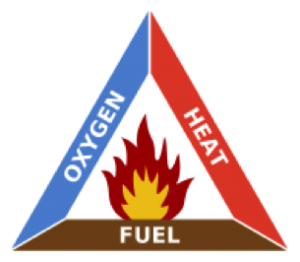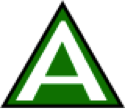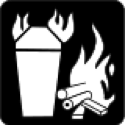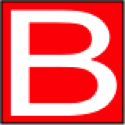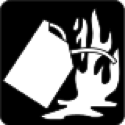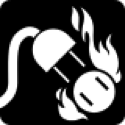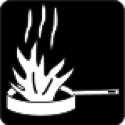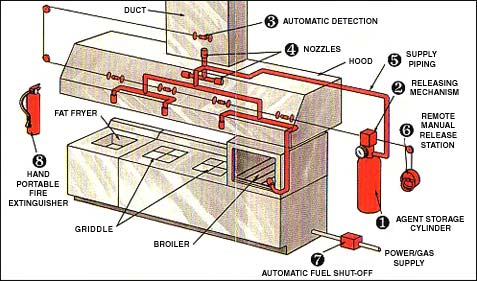The most important concept to remember is that you are responsible for your own safety and the safety of others. Most safety practices are common sense. Unfortunately, they can be forgotten or overlooked unless you make safe practices a habit or an instinct.
General Safety
By doing things right, you and your co-workers will commit yourselves to safety on the job and everyone will benefit. Accidents occur in many ways but most often can be traced back to one of two basic factors: ignorance or carelessness. You must always be concerned with your own safety and with the safety of others around you.
The following is a general list of safety precautions you must observe in any work area:
- Don’t fool around. “Horseplay” is one of the biggest causes of injuries on the job and it may be grounds for dismissal.
- Never work while under the influence of drugs or alcohol, as you are a hazard to yourself and your co-workers.
- Pay particular attention to moving objects, such as equipment, dollies, mixers, and slicers.
- Walk, do not run, in the work areas.
- Stay completely alert on the job.
- Avoid back strain by lifting properly.
Kitchen Accidents and Their Causes
Over 90% of all accidents are preventable, and three basic rules of kitchen safety, if enforced, will significantly reduce the likelihood of kitchen mishaps.
- Do not run: People who rush around in the kitchen tend to take chances that increase the likelihood of an accident.
- Keep your mind on your work: People who let their attention wander are a hazard to themselves and others around them. Lack of interest, personal problems, and distraction by others can all lead to serious accidents in the kitchen.
- Observe all the rules for operating kitchen equipment. Never operate kitchen equipment until instructed in the correct procedures.
In a commercial kitchen, safety is everyone’s job. It is a responsibility that must be accepted throughout the working day. As stated many times before, accidents are caused — they do not just happen. They are the result of not knowing the proper way to do a task, carelessly performing an operation or job, or not being consciously aware during the performance of a task. It is wise to remember that careless workers not only jeopardize their own health and well-being, but also jeopardize those around them.
Cooking is considered a fairly safe occupation, but hazards certainly do exist, not only in food preparation but in other related tasks as well. The most common accidents in the kitchen are cuts, burns, falls, and strains. All of these accidents happen when extreme carelessness or general horseplay is present. Carelessness and horseplay can be neither justified nor allowed in the commercial kitchen.
Cuts
Cuts are all too common in commercial kitchens because knives and other cutting implements are constantly in use. These cuts, and the seriousness of the cuts, however, can be held to a minimum by using ordinary good sense, by paying attention to the proper safety rules, and by practising proper cutting procedures. Once the skill of using a knife is developed, accidental cuts should not occur very often. However, when and if they do occur, they should be treated properly and without delay. If infection sets in, it can result in more serious consequences and the loss of many working hours. Remember: preventive care is always cheaper than injury treatment!
Burns
Two types of burns occur in the commercial kitchen: minor and serious. Minor burns are usually a result of wet or damp towels used to handle hot pots and pans, or from bumping an exposed area of your arm against a hot surface like and oven rack. More serious burns occur when grease is splashed, when steam escapes or is released too quickly, or when gas is turned on or released unknowingly. Burns are generally more painful than cuts, and they certainly take more time to heal. If the burn is severe enough to cause a blister, it should be treated promptly by trained medical personnel.
Falls
Falls can cause some of the most serious injuries in the commercial kitchen. They may disable or incapacitate a person for life. Falls are caused by extreme carelessness, wet floors and aisles, spilled food or grease, and by torn mats or warped floor boards.
Strains
Strains may not be as serious as other types of injuries, but they are painful and can result in the loss of many working hours. They are caused by carrying loads that are too heavy and by improper lifting practices. Most strains do not require medical attention, but they do require time and care to heal properly.
Safety Practices for the Kitchen
A kitchen has many safety hazards. It contains hot stoves, electrical equipment, and sharp tools. These hazards, combined with the busy, often frantic pace in a kitchen, make it very important that you work carefully while giving constant attention to the safety practices described below.
Lock-out procedures
WorkSafeBC regulations require that all powered machinery or equipment shut down for maintenance or repair must be secured against the possibility of the equipment being accidentally turned on while being worked on. To safeguard the person working on such equipment, lock-out procedures must be posted near the equipment, and the procedures listed must be followed before repairs or maintenance can start.
Locking out a machine usually means the power feeding the machine is disconnected either by pulling a plug, placing a switch in the off position, or turning a circuit breaker to the off position. The disconnected circuit is then secured in the inoperative position by the use of a padlock. The person doing the maintenance or repair keeps the key to this lock until the work on the machine has been completed. The worker then removes the lock and the machine is again operable.
Depending on the situation, the lock might be used to secure the power switch of the machine or it might be used to lock shut the door to a circuit breaker panel where the thrown breaker is located.
If the machine is not wired into its own power circuit but simply plugs into the wall, the lock-out procedure may require that the machine be turned off with its power switch and unplugged from the power receptacle. The plug end of the machine must be kept in plain view of the repair person so no one can inadvertently restore power without the repair person’s knowledge.
Kitchen machines that must be locked out before repairs or maintenance can commence include, but are not limited to, meat saws, dough mixers, meat grinders, garbage disposal systems and meat slicers.
You must be aware of the lock-out procedures that are to be followed before repairing or cleaning any machine. Lock-out procedures must be clearly posted by management near each machine.
A sample lock-out procedure notice is shown in Figure 16. As has been stated, this notice would be posted near the machine that must be locked out.
DOUGH MIXER LOCK-OUT PROCEDURE - SHUT OFF MIXER AT STOP/START SWITCH.
- SHUT OFF AT DISCONNECT BEHIND MIXER.
- APPLY LOCK TO DISCONNECT. PUT KEY IN POCKET. DO NOT LEAVE KEY IN LOCK!
- ATTEMPT TO START MIXER, RESET OR RETURN SWITCH TO “OFF” POSITION.
- COMPLETE WORK ON MIXER.
- ENSURE BOWL AND MIXER ARE CLEAR OF LOOSE PIECES, TOOLS, ETC
- REMOVE LOCK.
- RESTART MIXER AND RUN UP TO OPERATING SPEED.
|
Figure 16. Lock-out procedure notice
Procedures for equipment
- Never use any machine you have not been trained to use.
- Pull plug or throw switch to off position before cleaning or adjusting any machine. Keep fingers, hands, spoons, etc., away from moving parts. Wait until machine stops before moving food.
- Check all switches to see that they are off before plugging into the outlet.
- Particular care must be taken when cleaning the slicing machine.
- First pull the plug.
- Turn the gauge to zero in order to cover the edge of the blade
- Do not touch the edge of the blade
- Clean the blade from the centre out.
- Clean the inside edge of the blade with a stick that has a cloth wrapped around one end.
- Do not start a mixer until the bowl is locked in place and the attachments are securely fastened.
- When using a mixer, turn off motor before you scrape down the sides of the bowl.
- Use a wooden or plastic plunger rather than your hands or spoons to push meat down into a meat grinder.
- Keep your hands to the front of the revolving bowl when operating the food cutter. This is one of the most dangerous pieces of equipment in the commercial kitchen.
- Never start a machine until you are sure all parts are in their proper places. If it is a machine that operates with gears, check the gear position.
- You must be aware of the lock-out procedures that are to be followed before repairing or cleaning any machine. Lock-out procedures must be clearly posted by management near each machine.
- When using electrical power equipment, always follow the manufacturer’s instructions and recommendations. Do not wear rings, a wristwatch, or a tie when operating electrical power equipment.
Procedures for sharp utensils
- Use the right knife for the job.
- Do not grab for falling knives. When a knife starts to fall, jump backward to get out of the way.
- Always carry a knife with the tip pointing downward and with the cutting edge turned away from your body.
- Never talk while holding a knife in your hand. Should you start to gesture with the knife, there could be serious consequences.
- When cutting with any knife, always cut away from your body. This also applies to potato peelers or any implement with a cutting edge.
- Never place a knife in hot water as it will cause cracks in the wooden handle. Never reach into soapy water in search of a knife.
- Use a cutting board at all times. Never cut on metal.
- Place knives in designated knife drawers. Preferably, knives should be placed in knife racks for proper storage.
- When cleaning or wiping a knife, keep the sharp edge turned away from your body.
- Always use a sharp knife; it is much safer than a dull one. Less pressure is required on a sharp knife, and the chances of a sharp knife slipping are much less.
- Always cut with a back and forth sweeping motion, not with downward force.
- Use knives for the purpose for which they are designed, not as levers or wedges or as bottle or can openers.
- Pick up knives by the handle only.
- Take a firm grip on a knife handle and always make sure the handle is free of grease or any other slippery substance.
- When slicing round objects such as onions or carrots, cut a flat base so the object will sit firmly and not shift when being cut.
- Never force a meat band saw; it may jump from the bone.
- When using a cleaver, be sure the item to be chopped is sitting solidly. Note: Avoid chopping large, hard, or brittle bones with a cleaver as the bones may splinter and become as dangerous as flying glass.
- When grating foods, never work the foods too close to the cutting surface.
Avoid burns
- Use dry towels when handling hot skillets, pots, or roasting pans as wet cloth conducts heat more readily than dry cloth.
- Avoid splashing grease on top of the range. Grease will ignite quickly, causing a fire. Do not throw water on a grease or fat fire: smother it. Use a foam extinguisher or a wet towel.
- Remove the lids of pots slowly. Lift the side of the lid that is away from you so the steam does not rush out too quickly, causing burns to your hands or face.
- Always give notice of “hot stuff” when moving a hot container from one place to the other.
- Keep towels used for handling hot foods off the range. Too often, the end of the towel is dangled into or drawn across the fire.
- Avoid overfilling hot food containers.
- Never let the long handles of saucepans or skillets extend into aisles. If they are brushed, hit, or bumped the pot may fall off the range.
- Never turn the handle of any pot over an open flame.
- Place a lighted match to gas jets before turning on the gas. Ventilate gas ovens for a few minutes before lighting by leaving the oven door open so any gas pockets that might be present can escape.
- Know the location of fire extinguishers; know how and when to operate them.When placing food in hot grease, always let the item slide away from you so the grease will not splash toward you and cause a serious burn.
Keep floors safe
- Wet floors are dangerous. Keep them dry.
- Pick up or wipe up any spilled item immediately, particularly water or other similar liquids.
- When liquid or fat is spilled, have one person watch the area and warn others of the danger while another goes for a mop. Small areas may be sprinkled with salt to provide traction until the spill is cleaned up.
- Walk. Do not run or slide across the floor.
- Never leave utensils on the floor. Someone is sure to trip over them, and it may be you.
- Keep all traffic areas clear of boxes, garbage cans, portable equipment, mops and brooms, etc.
- When mopping kitchen floors, do only a small area at a time.
- Using rubber mats behind the range is a good practice. However, mats must be kept in first-class condition by daily cleaning and by replacement when they begin to wear.
Handle glassware and china safely
- Use care in handling glasses and dishes.
- When carrying china and glassware from one place to another, be alert and move cautiously. Keep complete control of the load at all times.
- Discard all glass or other china items that are chipped or cracked.
- Keep glasses and china out of the pot sink.
- Never place glassware in soapy water. Wash glassware in a dishwasher, using a compound recommended for glasses.
- If you suspect there is broken glass in soapy water, drain the water, then remove the pieces carefully with a paper towel.
- Never use glassware in forming or preparing food. For example, do not cut biscuits or ladle liquids with a glass item.
- Do not use a glass as an ice-cream scoop. It may break in your hand.
- Use a pan and broom to sweep up large pieces of broken glass or china. Use a dampened paper towel to pick up the slivers. Put broken glass in a special container. Do not place broken glass in wastebaskets.
Store supplies safely
- When opening boxes, crates, etc. remove the nails. Do not bend them down.
- Always store heavy materials on bottom shelves, medium-weight materials next, and light-weight items on top shelves.
- Get rid of all dirt, grease, and trash promptly to reduce fire hazards and to eliminate breeding places for rats and cockroaches.
- Be sure light bulbs are guarded. As a precaution against fire, do not store any materials within 45 cm (18 in.) of any bulb.
- Use ladders, not boxes or chairs, to get things from high shelves. Always have three points of contact when moving up and down the ladder. Do not over reach, and never stand on the top two rungs of the ladder.
Dispose of refuse properly
- Place food scraps in proper containers.
- Do not allow containers to overflow. Empty them before they are completely full.
- Do not stack full refuse containers.
- Report broken or defective containers.
- If wearing gloves while disposing of refuse, you should remove the soiled gloves once the job is done and, when returning to work, wash and sanitize hands properly
- Push garbage down using a tamper or other tool. Do not push it down with your hand or foot!
Lifting practices
- Keep your back straight, but not necessarily vertical. Have a sure grip on the object.
- Keep the object close to your body.
- Bend your knees before lifting.
- Lift with your legs, not with your back.
- Call for help to lift or move heavy pots or containers.
Housekeeping
Good housekeeping is an important part of safety and accident prevention. Many unsafe conditions can be corrected before they result in injury. Good housekeeping is a necessity for a safe and sanitary kitchen. A clean work environment leads to pride in workmanship and a safe operation.
Good housekeeping procedures include the following:
- Do not block exits.
- Change burned-out light fixtures in work areas, walkways, and exits.
- Keep floors and work areas clean, dry, and grease-free.
- Keep steps and ladders in serviceable condition.
- Keep emergency equipment clean and unobstructed.
- Ensure that all signs and caution labels are in good condition and visible.
Personal Protective Equipment
In addition to being aware of the mechanical hazards in the kitchen, it is important that you use the correct protective clothing and equipment. Wearing personal protective equipment (PPE) can prevent accidents from happening. As a worker, you are responsible for the following:
- Making sure your uniform is well fitted.
- Keeping all uniforms clean and in good condition, not frayed or badly worn.
- Making sure sleeves are kept buttoned at the wrist, cuffs on overalls and trousers are be eliminated, and trouser legs are long enough to hang outside boots.
- Wearing specific personal safety equipment such as goggles, hearing protection, gloves, and aprons when required.
To ensure that you are protecting yourself, your personal protective equipment (PPE) list should include the following items.
Clothing
This includes well-fitted pants and jackets with all buttons fastened. Sleeves should be close fitting because sleeves that are loose and flowing are potential fire hazards when working over open gas burners. Health regulations require that all food handlers wear hair nets or use other approved methods for keeping hair under control. Aprons should be made of non-combustible and flame-resistant materials that do not melt under heat.
Footwear
The OHS Regulation requires that approved footwear must be worn by employees in all industrial occupations. Ensure your footwear is sturdy and provides enough back support to not cause future back problems. Footwear suitable for commercial foodservice establishments must have a non-slip sole and a closed toe and closed back.
Your footwear should be sturdy and comfortable, and if the environment you work requires steeled toes, such footwear should be worn. High leather tops on shoes are a good idea as they will protect your feet from hot grease or liquids.
Hand protection
The most common type of gloves used in food service establishments are natural rubber latex gloves, synthetic rubber gloves, and vinyl gloves. As it is impossible to distinguish between natural and synthetic rubber gloves simply by looking at them, you should read the label on the box to determine what they are made of. Some people may have an allergic reaction (known as dermatitis) or a more serious reaction known as anaphylaxis to the natural latex glove, and for this reason natural latex gloves are not recommended for use when preparing food.
Mesh gloves should be used when cleaning the meat slicer. Thick plastic, gloves should be used when handling cleaning products.
Eye protection
Eye protection in the form of safety goggles or masks should be worn whenever there is a chance of eye injury. Particles flying through the air can easily land in your eye and possibly do permanent damage. Eye protection is important, for example, when working with the band saw cutting through bone or when working with corrosive cleansers that could splash into your face.
Hearing protection
Approved hearing protection must be worn when high-level noise conditions exist. These conditions are not common in commercial kitchens but may be present in food manufacturing operations.
Respirators
Respirators should be used to protect yourself from inhaling harmful fumes or vapours such as those that often come from concentrated kitchen cleaning liquids. The respirator unit should be properly fitted to provide the best protection. Check the components to ensure they are not broken, cracked, or torn and that they do not have holes. Replace faulty components before use. Each unit will have a filter that should be checked regularly and replaced before the expiration date.
Equipment Safety
Extreme care should be taken when operating equipment. Before you attempt to operate any tool or piece of equipment, you must be fully trained by an experienced operator. Make sure that all guards are in place and function properly and that all electrical connections are properly made. You should observe the following precautions when using equipment:
- Understand the correct operating procedures and safety precautions before operating a piece of equipment.
- Ensure that all guards are in place and functioning before any machine is started.
- Report defective or unsafe equipment to a responsible individual to prevent serious injury.
- Do not distract or interfere with the equipment operator.
- Make sure that the cords to electrically powered tools are in good condition, with no frayed parts or bare wires showing and make sure that the tools are properly grounded.
- Keep edge-cutting tools properly sharpened so that they do the job well and do not have to be forced because of dull edges.
- Use tools only for their intended use and make sure the size of the tool is right for the job.
- Report to your immediate supervisor any tool or piece of equipment that is broken or does not function properly.
Ventilation systems
The environment in which you work is very important. The air around you may be filled with smoke and steam.
Kitchens have some type of ventilation equipment usually housed in the same units as the fire suppression systems. Many other types of ventilation equipment may be found in workplaces. It is important, regardless of where you are working, to become familiar with the ventilation equipment or systems and use them.
Emergency shutdown systems
Many kitchens have emergency shutdown systems or “panic buttons.” These are installed so that only one switch has to be thrown to kill the power to a large amount of equipment. These systems are to be used when a person is being electrocuted or is caught in a piece of machinery. Under these circumstances, you do not have time to hunt for and throw the correct switch. Fast action is necessary. Hit the panic button.
When you enter a kitchen for the first time, locate and learn how to use the emergency shutdown.
Guards and barriers
Guards and barriers are used as safety devices on many pieces of equipment used in a modern kitchen. Always use them to ensure you are operating the machinery in the safest way possible. Never operate a piece of equipment unless all guards and barriers are in position.
Utilities
Each time you have a new work location, check the location of the shutoffs for all of the utilities. That way you will be prepared for an emergency.
Electrical
You should make yourself aware of the location of the main panel or sub-panels being used, and you should learn how to shut them off in case of an emergency. If you must shut the power off, notify your supervisor right away. Obtain permission from the electrician before using a new service.
Electrical extension cords, if they need to be used, should be orderly and not allowed to become tangled. Such cords should be taped to the floor whenever possible as this will reduce the chance of someone tripping over them
Electrical safety
Even though you may normally deal with low voltages and current, the values are never far away from lethal levels. You can receive a shock or burn from any common electrical circuit. The severity of the electrical shock depends on four factors:
- The amount of current that passes through the body
- The path that the current takes through the body
- The frequency of the current
- The length of time that the current flows within the body.
Normal household current (plugs and light circuits) is generally limited by a circuit breaker to a value of 15 amps. This device has been designed to trip and open a circuit if the 15 amp value is exceeded. It is possible to cause fatal injury with a current flow of only 50 milliamperes (mA). One milliampere (1 mA) is one one-thousandth of an amp.
It is easy to see that the body is sensitive to relatively small values of current. In comparison, a 100 watt light bulb draws approximately 0.85 amp (850 mA) of current when connected to a 120 volt source. Remember, there are 15 amps available in each standard house circuit. Industrial circuits may have a required flow of several hundred amps. In both cases, these are dangerous amounts!
In order for you to get an electrical shock, you must become part of the electrical circuit. You have to contact a live portion of a circuit while in contact with a lower potential such as a ground. Such an arrangement will complete an electrical circuit through your body to the ground, causing current to flow.
Water supply
Find out where the water shutoff is located in your kitchen. If a pipe breaks or bursts, the water may damage material, tools, and equipment or work already done. In addition, water may create an electrical hazard if it comes in contact with electrical panels or outlets. If you must shut the water off, notify your supervisor at once.
Gas supply
Locate the gas shutoff in the kitchen. Escaping gas can cause an explosion that could injure someone or do great damage. When the valve handle is running parallel with the gas line, the supply of gas is flowing and on. By turning the valve handle 90 degrees (that is, perpendicular to the gas line), you can shut off the gas supply. If you must shut off the gas, notify your supervisor immediately. Remember, you must have the gas flowing in order to light the pilot lights on equipment.
Other services
Other services, such as telephone, cable, and Internet, do not usually present any danger to people, and there is no way you can shut them off. If the lines for these services are broken or cut and if they must be located and repaired or moved, get in touch with the company that supplies the service.

